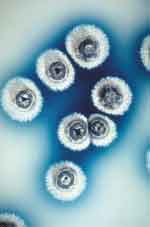Life Sciences and Chemistry
Articles and reports from the Life Sciences and chemistry area deal with applied and basic research into modern biology, chemistry and human medicine.
Valuable information can be found on a range of life sciences fields including bacteriology, biochemistry, bionics, bioinformatics, biophysics, biotechnology, genetics, geobotany, human biology, marine biology, microbiology, molecular biology, cellular biology, zoology, bioinorganic chemistry, microchemistry and environmental chemistry.

Scientists Succeed in Growing ’Uncultivable’ Microorganisms
Of the estimated 10,000 to 100,000 microbial species that inhabit our planet, scientists can only coax a few thousand to grow in the laboratory. As a result, efforts to categorize the vast diversity of microbes are lagging far behind attempts to classify plants, animals and insects. Now a report published in the current issue of the journal Science suggests that some of these so-called uncultivable microorganisms might not be so out of reach after all.
Tammi Kaeberlein, Kim Lewis and Klava

The Role Of Phytochromes In Bacteria Revealed
A research team jointly involving the IRD, the CEA and the CNRS has very recently found phytochromes in a strain of nitrogen-fixing bacterium, Bradyrhizobium (1), symbiont on certain tropical leguminous plants (the Aeschynomene). Techniques of molecular biology, biophysics and biochemistry revealed that the newly-discovered phytochrome has an essential role as regulator of the bacterium’s photosystem synthesis. An identical function was shown in the photosynthetic bacterium Rhodopseudomonas palustris

Gardens in space
A model of a system for growing plants to plan biological experiments in space has just left the company of ROVSING, in Ballerup near Copenhagen, on its way to ESA’s European Space Research and Technology Centre (ESTEC) in the Netherlands.
The full name of this experiment reference model is European Modular Cultivation System Experiment Reference Model (EMCS ERM). This will be used at ESTEC to plan and carry out experiments for growing plants in space. Then in 2003 the EMCS Flight Model will

No association between ageing gametes and birth defects
Authors of a research letter in this week’s issue of THE LANCET conclude that there is no evidence to support the belief that sexual intercourse too soon or two long after ovulation is associated with an increased risk of birth defects and Down’s syndrome.
For many years, the ageing of gametes as a result of prolonged retention in the female reproductive tract before fertilisation has been circumstantially associated with major birth defects. Joe Leigh Simpson and colleagues from Baylor Coll

Cutting edge – Scientists have combined a cutting ribosyme activity with an unwinding helicase activity
Scientists have long toyed with the idea of putting to work a special class of biological catalysts, called ribozymes, as therapeutic agents. These molecular scissors would harness the activities of overly active genes that contribute to diseases like cancer by cutting their immediate products, messenger RNAs, into unusable pieces. The advantage of this approach, is that these molecules can be made to recognize very specific targets. This is reported in this month issue of EMBO reports.
Up u

Scientists sequence Nature’s antibiotic factory
The genome sequence of Streptomyces coelicolor , one of the family of common soil bacteria that produce more than two thirds of the world’s antibiotic medicines, will be published in the journal Nature this week.
Streptomyces are almost ubiquitous in the soils and are responsible for its familiar ‘earthy’ smell. The genome data, collected by British scientists from the John Innes Centre and The Wellcome Trust Sanger Institute, is already being used in research that will help de